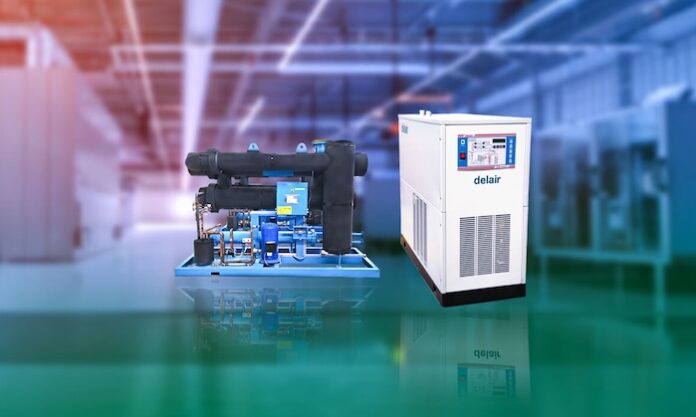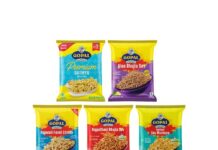India’s food & beverage industry is undergoing massive growth, majorly fueled by increasing domestic demand. Rapid urbanization and busy lifestyles are responsible for the changing behavior of consumers who prefer convenience food and beverages on the go. The Indian food processing industry is also growing at a phenomenal rate, expected to reach US$700 billion by 2030, says a PHDCCI report.
As such, it becomes mandatory to ensure the safety, hygiene, and compliance of the food processing sector to give a desired impetus to its growth. This underscores the importance of compressed air solutions in the food & beverage industry to enhance the quality and palatability of food. These solutions come in handy to combat moisture-related issues in the F&B industry.
Moisture is a threat to the F&B industry as it promotes the growth of microorganisms such as fungi, mold, and pathogens. It brings about physical, enzymatic, microbiological, and biochemical deterioration of food – rendering them unsuitable for consumption. Moisture is basically introduced to food with the help of compressed air and finds application in a wide range of processes throughout the manufacturing, transportation, and packaging operations. It comes into contact with food at every stage of processing, and if the pressurized air is laden with moisture, it can be disastrous.
The uses of compressed air
Compressed air is crucial for the F&B industry, as it is required for conducting freezing, canning, and dehydration of food products. It is responsible for driving dairy processing or agitation, vacuum sealing, packaging of food, processing of meat, etc., to name a few operations.
Along with facilitating various operations involved in the F&B sector, compressed air empowers pneumatic machines, which are important for fueling conveyors, sorters, mixers, and bottling lines. In addition, compressed air is essential for the functioning of other equipment as well that oversees the filling of cakes, pies, liquid products, etc.
In addition, compressed air is utilized in the manufacturing of PET bottles, where it plays a crucial role in giving the desired size and shape. During the bottle manufacturing process, it drives the forming, mold press powering, clamping, and conveyance of plastic pellets. In case the compressed air has moisture, it clouds the PET bottles and compromises on clarity and strength. Moisture even contaminates the PET resin, giving rise to internal bubbles and pockmarks in bottles or containers.
The repercussion of moisture goes beyond food products and give rise to the malfunctioning of pneumatic machines. It leads to sluggish and inconsistent functioning of valves and cylinders, which interferes with the seamless completion of various operations. At the same time, moisture goes a long way in triggering corrosion throughout the pipelines, cylinders, and other components. The problem is further escalated in cold weather, where the moisture freezes in the machines.
Refrigeration dryers come to rescue
To address the issue of moisture in the F&B industry, it becomes mandatory to deploy High Pressure Delpet refrigeration dryers to ensure a continuous supply of quality compressed air that is devoid of contaminants. It helps mitigate moisture from the compressed air and purifying it from dust particles, oil, and solid contaminants in the process. The dryers are proficient at achieving Quality Standard of ISO 8573-1:2010 and ensure best pressure dew point from +3°C to + 4°C.
The High Pressure Delpet refrigeration dryers remove the moisture by cooling down the air to nearly the freezing point. Following this, the cold air is reheated at nominal conditions to approximately 10°C below the temperature with respect to incoming compressed air. The dryers are made up of a refrigeration circuit, a compressed air circuit, and air drying units that encompass a centrifugal cum demister pad condensate separator. Similarly, the refrigeration circuit consists of a compressor, a condenser, a receiver, a volume liquid accumulator with liquid refrigerant, and an evaporator.
Here, the heat exchangers, incorporating an air-to-air heat exchanger and a refrigerant-to-air heat exchanger, are the heart of the system. It is responsible for steering the out-performance of the dryers, where it reduces the load on the refrigerant system with the help of an air-to-air heat exchanger. At the same time, the air-to-air heat exchanger performs the warming of the outgoing cold air pipelines to the desired temperature. Alternatively, the refrigerant-to-air heat exchanger drives the cooling of air to the required temperature, and promotes condensation of water vapor in the air, which otherwise is prone to being drained out easily.
In addition, High Pressure Delpet dryers are used in PET bottle manufacturing. The dryers should be prioritized for their ability to cool the air to nearly freezing point in order to eliminate the moisture at a high pressure of 40 barg and a maximum of up to 45 barg in some special PET applications. Hereafter, cold, dry air is reheated to approximately 10°C lower than the incoming compressed air temperature at nominal conditions.
With the Indian food & beverage industry standing at a very interesting cusp of development, it becomes essential more than ever to preserve the quality of food. Industry players have to understand that moisture is a major threat to the sector, and proactively adopt compressed air dryers to supply quality air solutions for the various processes involved in the F&B sector. Being adept at eliminating moisture, it comes in handy for preventing contamination of food & beverages while keeping their taste and palatability intact.
IndiFoodBev — authentic, impactful and influential
An English-language food and beverage processing and packaging industry B2B platform in print and web, IndiFoodBev is in its third year of publication. It is said that the Indian food and beverage industries represent approximately US$ 900 billion in revenues which implies more than 20% of the country’s GDP. Eliminating the wastage on the farmside can help to deliver more protein to a higher number of the population apart from generating sizable exports. The savings in soil, seeds, water, fertilizer, energy and ultimately food and nutrition could be the most immense contribution that country is poised to make to the moderation of climate change.
To improve your marketing and grow sales to the food and beverage processing and packaging industry, talk to us. Our research and consulting company IppStar [www.ippstar.org] can assess your potential and addressable markets in light of the competition. We can discuss marketing, communication, and sales strategies for market entry and growth.
Suppliers and service providers with a strategy and budget for targeted marketing can discuss using our hybrid print, web, video, and social media channels to create brand recognition linked to market relevance. Our technical writers are ready to meet you and your customers for content.
The second largest producer of fruit and vegetables in the world is continuously expanding processing capacities and delivery systems with appropriate innovative technologies. We cover product and consumer trends, nutrition, processing, research, equipment and packaging from farm to thali. Get our 2025 media kit and recalibrate your role in this dynamic market. Enhance your visibility and relevance to existing markets and turn potential customers into conversations. Ask for a sample copy of our bi-monthly in print or our weekly IndiFoodBev eZine each Wednesday.
For editorial info@ippgroup.in — for advertisement ads1@ippgroup.in and for subscriptions subscription@ippgroup.in
Naresh Khanna – 10 February 2025
Subscribe Now











